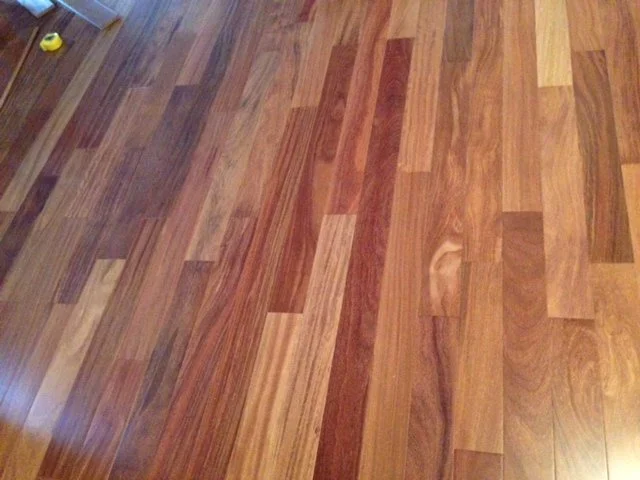Why Domestic Hardwoods Are Always the Safer Bet for Northeast PA Stability
If you are renovating a home in the Bucks County suburbs like Newtown or Solebury, or tackling an older colonial in Montgomery County towns like Ambler, you’ve likely been dazzled by exotic hardwoods like Brazilian Cherry, Tigerwood, or Ipe. Their colors are stunning, and the Janka hardness numbers are impressive.
But here is the truth that often gets left out of the sales pitch: Exotic wood is a gamble in the Northeast climate.
It’s not about strength; it’s about stability. We’re going to break down exactly why domestic species—namely White Oak and Maple—will always give you less headache and a longer-lasting floor in Pennsylvania than their tropical counterparts.
The Northeast Climate: A Hardwood Killer
Our region is one of the most challenging places in North America for hardwood floors. It’s not just four seasons; it’s four extremes of moisture. Hardwood is hygroscopic, meaning it constantly trades moisture with the air. A successful floor installation relies on the wood being milled and acclimated for a regional Equilibrium Moisture Content (EMC) that averages between 6% and 9%.
The problem is that exotic species are accustomed to a stable, high humidity (tropical) environment. When you force them into a rapidly shifting, low-to-high humidity environment like ours, the stress often causes unpredictable movement.
Australian Cypress Hardwood Floor
The Domestic Advantage: Built to Handle the Swing
Domestic hardwoods—Red Oak, White Oak, Maple, and Hickory—have been growing here for millennia. They have evolved to handle the wild, 40-degree temperature swings and the seasonal humidity changes of the Northeast.
Here’s why they are the better investment:
1. Predictable Movement
All wood moves, but domestic wood moves in a way we can predict and manage. This comes down to two properties:
Radial Shrinkage: The movement across the growth rings.
Tangential Shrinkage: The movement parallel to the growth rings.
Domestic woods have a lower overall dimensional change rate than many exotics, meaning they shrink and swell less for the same change in moisture content. When we install White Oak, we know exactly how much gapping to expect in a dry winter. When we install Brazilian Cherry, the shrinkage can be erratic and sometimes forces the planks apart wider than the tongue-and-groove joint can handle. For instance, installing a White Oak floor in a historic Doylestown farmhouse requires a different moisture-testing protocol than a new construction home in Warrington. This is why a local expert who understands Chester County's mix of old and new properties is essential.
2. Better Milling and Drying Standards
American mills that handle domestic species are perfectly calibrated to dry lumber to the exact 6%–9% MC range needed for installation in the Northeast. This is not always the case with imported exotic woods:
MC Mismatch: Imported wood may arrive at 11% or 12% MC, which is suitable for a tropical port but will shrink excessively when introduced to a furnace-heated PA home in winter.
Inconsistent Quality: Quality control standards can vary widely overseas. We've seen exotic stock that is not square or has excessive internal tension, which leads to immediate issues upon installation.
3. Specific Domestic Winners for PA
If you’re building new or installing over radiant heat, we recommend White Oak every time. It has a closed grain structure that makes it more resistant to moisture absorption than Red Oak, giving it superior stability and making it the ideal choice for managing our humidity shifts.
The Exotic Factor: High Hardness ≠ High Stability
Homeowners often choose exotic floors because the Janka hardness score is much higher than Oak (which is true), but high hardness only measures resistance to denting. It has nothing to do with how the wood manages water.
Here are the practical risks of installing exotics in this region:
The Unmanageable Gap: We routinely see exotic floors shrink up to 1/8 inch between planks during the winter dry season. This creates unsightly black gaps that look terrible and collect dirt. Domestic wood, properly installed, typically gaps less than half of that.
Warping and Stress: When exotic wood acclimated at 10% MC is introduced to a bone-dry 6% environment, the extreme tension can cause planks to pull apart from the subfloor, leading to popping sounds and board separation.
Refinishing Difficulty: Exotic woods like Ipe and Brazilian Cherry are incredibly oily, which makes them highly difficult to stain and seal. The oils repel the finish, and if the floor ever needs to be patched, color matching is nearly impossible.
The Cyclone Hardwood Installation Standard: How to Prevent Failure
If you are determined to use an exotic species, you must hire a contractor who follows these non-negotiable standards. This is what separates a professional from a handshake crew.
Strict Moisture Content (MC) Testing: Before a single board is laid, we use a calibrated moisture meter to test the wood planks, the subfloor, and the air. Installation only proceeds when the wood MC is within 2% of the subfloor MC. We use technical data from the National Wood Flooring Association (NWFA) to ensure this.
Extended Conditioning Time: Acclimation isn't just dropping the boxes in the garage. The wood must be stacked and stickered in the specific room it will be installed in for a minimum of 7–10 days, allowing it to condition to the living environment.
Proper Spacing: We use wider expansion gaps (at the walls, under baseboards) for exotic wood to allow for the greater movement we anticipate.
For peace of mind and long-term beauty in your Northeast PA home, whether you're in Lower Gwynedd or renovating a home near Valley Forge, our recommendation is always a domestic species like White Oak. Contact us today—we service all of Bucks, Montgomery, and Chester Counties.
Ready to talk about the right wood for your property?
Call us today for a free, detailed estimate that accounts for your home's specific environment.


